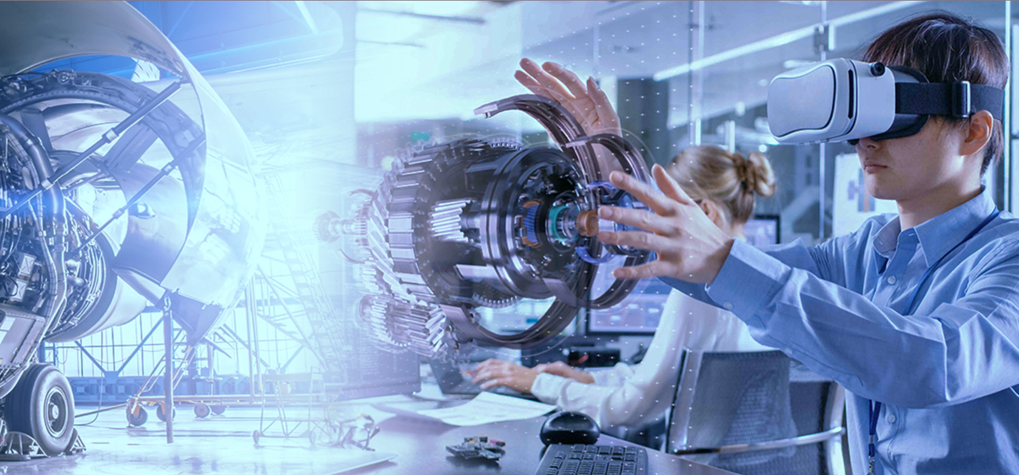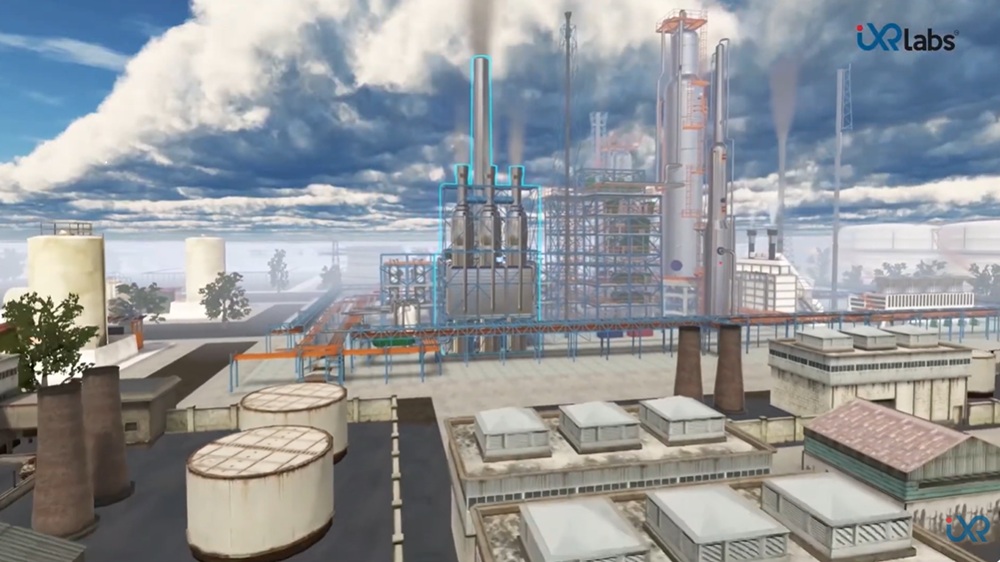Virtual Reality in Aeronautical Engineering: VR in Aviation Education

Aeronautical engineering has always been at the forefront of groundbreaking innovations, pushing the boundaries of what's possible in the skies. Now, with the advent of Virtual Reality (VR), the domain of aeronautics is on the brink of another transformative leap.
Merging the immersive world of VR in engineering with the intricacies of aerospace gives us a unique lens to see, feel, and experience the vastness of the aviation industry like never before.
From stepping inside an aircraft's design to virtually exploring every nook and cranny of a jet engine, VR is truly taking aviation education and operations to new heights. Dive in with us as we explore the soaring potential of VR in the world of aeronautical engineering in this blog.
But first, let’s see what exactly is VR in aeronautics.
What is VR in Aeronautics?
Virtual Reality in aeronautical engineering embodies the synthesis of two cutting-edge domains, i.e., the captivating world of immersive technology and the ever-evolving domain of aerospace science.
At its core, VR in aeronautics offers a depth far beyond mere visualization of aircraft models in a digital 3D environment. It's an avenue for profound immersion, where engineers and students can "feel" the space around them.
This immersive quality promotes nuanced interaction with aircraft components, offering a tangible sense of scale, positioning, and relationship among parts.
The potential for innovation with VR is vast.
Beyond just a static viewing of a plane's structure, imagine "standing" on a virtual runway, feeling the adrenaline as you simulate the intricate process of landing amidst turbulent conditions, or "hovering" beside a roaring virtual jet engine, getting insights into its complex mechanics.
Moreover, VR in aeronautics provides an unparalleled platform for collaborative work. Students can come together in a shared virtual space, discussing and tweaking designs in real-time, irrespective of their geographical locations.
It blurs the line between reality and simulation, making complex concepts more accessible, understanding more intuitive, and innovation more feasible.
Through this dynamic tool, the aerospace industry is set to redefine its teaching methodologies, research processes, and operational procedures.
"Immerse yourself in the world of aviation and explore the intricacies of aircraft design through interactive VR simulations."
Virtual Reality in Aircraft Design
Aircraft design stands as one of the cornerstones of aeronautical engineering. Each segment, from the smooth contours of the fuselage to the optimized aerodynamics of landing gear, is the result of rigorous deliberation and expertise.
The aim of aircraft design is not only to make the aircraft functional but also efficient, durable, and safe.
But now, infuse this meticulous process with the capabilities of Virtual Reality.
Engineers, by simply donning a VR headset, have the opportunity to embark on an explorative journey right within their very creations.
Imagine strolling within the spacious cabin of a commercial jet or navigating the narrow corridors of fighter jets, feeling the proximity of internal systems in the turbofan jet engine, and understanding the spatial relationships between various components of the aircraft landing gear, etc.
This isn't mere visualization!
It's an experiential insight into design. Where a 2D blueprint might show the layout, a VR model showcases the ambiance. Flaws that could be overlooked on paper or screens, such as awkwardly placed components, potential obstructions, or airflow disruptions, come to the forefront in a tangible 3D space.
Furthermore, this immersive experience aids in perceiving ergonomics from a passenger's or pilot's perspective, ensuring maximum comfort and functionality.
With VR, real-time modifications become possible. Engineers can make adjustments on the fly, experimenting with different configurations and instantly visualizing the results.
This not only accelerates the design process but also enhances precision, leading to aircraft that are not just operational but also optimized for performance, comfort, and safety.
VR in Aviation Training
MRO Network's prediction of doubling the number of civil aviation passengers by 2036 has far-reaching implications.
The aviation industry is facing the challenge of training more engineers to maintain the burgeoning machine fleet.
With the aviation maintenance training market witnessing a CAGR of 7% from 2020 to 2023, there's a consequent rise in educational institutions. However, a crucial problem emerges, i.e., the constraint of infrastructure.
With physical limitations in place, not all budding engineers get the invaluable hands-on experience they need in Aircraft Maintenance Engineering (AME).
However, virtual reality can bridge this infrastructure gap.
Through VR in aviation training, institutions can offer students ample training time, immersing them in complex structures like jet engines and turboprops without the need for physical prototypes.
No longer do students need to wait their turn or be limited by the availability of physical aircraft models.
With VR headsets, they can instantly be transported into virtual hangars and workshops where an array of aircraft awaits their inspection and understanding.
In these VR-based settings, every student can have personalized, in-depth interactions with aircraft components.
Imagine the depth of learning when a student, seated in a classroom, can virtually step inside a roaring turbofan engine, dissecting it layer by layer, exploring every cog, bolt, and blade.
Such immersive experiences demystify the complexities of aviation machinery, allowing students to comprehend the nuances of each part, its function, and its relevance in the larger scheme of operations.
Moreover, VR-driven training modules can simulate a plethora of real-world scenarios, from routine maintenance tasks to critical emergency repairs, giving students a foretaste of the challenges they might face in their careers.
They can practice, re-practice, and perfect their skills in a risk-free environment. Errors in the virtual world have no real-world consequences, but the lessons learned are genuine and invaluable.

Get the App from Meta Store: Download Now
The Expanding Horizon: VR in Aerospace Industry
✔️ Safety Protocols
Safety remains paramount in the aerospace sector, given the sheer complexity and risk involved in operations. From the meticulous design stages of aircraft and spacecraft to their final voyages, ensuring that every process is foolproof is essential.
Virtual Reality offers a unique training solution in this context. For instance, astronauts embarking on deep-space missions can use VR to familiarize themselves with extraterrestrial terrains, practicing maneuvers and protocols within the safe confines of a simulated environment.
Similarly, aviation engineers can test emergency evacuation plans or troubleshoot critical issues during flight through hyper-realistic VR simulations.
This real-time, immersive rehearsal ensures that when confronted with actual challenges, our aerospace professionals are well-equipped and confident.
✔️ Collaborative Design
Just as we've seen collaborative potentials with VR in mechanical engineering and VR in electrical engineering, the aerospace industry is no exception.
No longer are engineers bound by geographical distances or time zones. Virtual Reality facilitates a global meeting ground where minds from every corner of the globe can collaborate in real time.
This seamless integration amplifies the design process's efficiency and innovation, pooling global expertise to shape the future of aerospace.
✔️ VR Labs
Taking a cue from why engineering colleges should use VR labs, aeronautical institutions can adopt virtual reality labs. Here, students can interact with virtual models of aircraft systems, understanding nuances that traditional labs might not offer.
A student curious about the Mars Rover's mechanics can virtually traverse the Martian landscape alongside it. Those intrigued by deep-sea drones or high-altitude satellites can dive deep or soar high, all while staying grounded in their classroom.
These experiences, beyond being visually spectacular, embed deep-rooted understanding and curiosity, attributes essential for the aerospace engineers of tomorrow.
✔️ Looking Ahead The Virtual Flight Path
The rapid integration of virtual reality in aeronautical engineering is a testament to the technology's potential and the aerospace industry's visionary approach.
As the demand for trained professionals in aviation continues to surge, it's imperative for educational institutions to leverage VR for higher education, ensuring students are equipped, enlightened, and ready to navigate the skies.
In conclusion, the synergy of virtual reality in aeronautical engineering is reshaping the future of aviation. Be it the design intricacies, training proficiencies, or collaborative innovations.
VR is poised to elevate the aerospace industry's horizons, ensuring safer flights and brighter futures.
At iXR Labs we believe in the power of virtual reality in higher education particularly in engineering, medical, and science colleges.
If you are fascinated with the idea of integrating virtual reality solutions into your institutions you can visit www.ixrlabs.com
.png)




